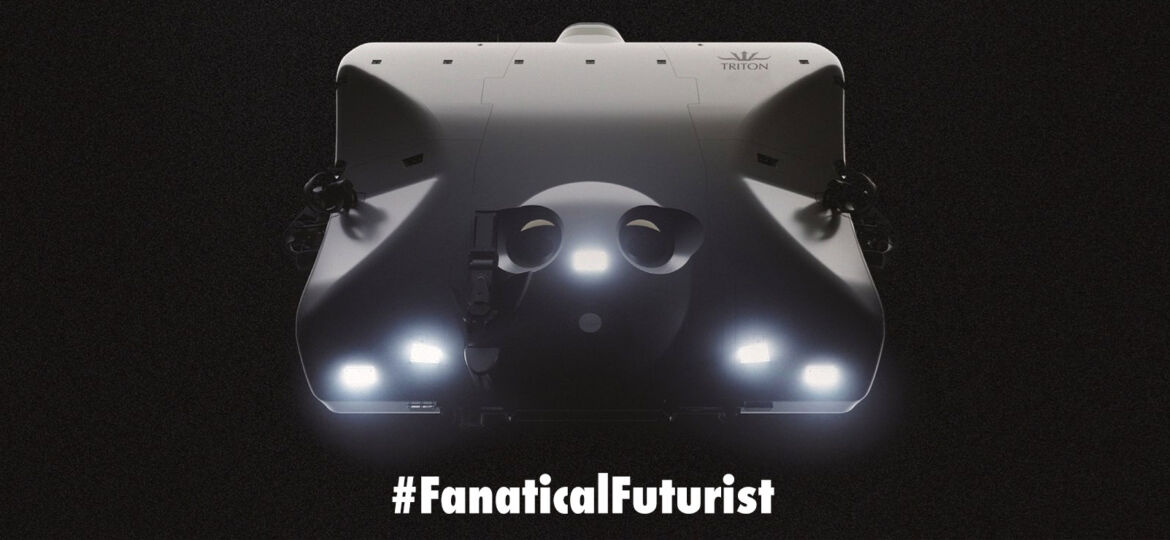
WHY THIS MATTERS IN BRIEF
Technology isn’t just democratising mobility above ground, it’s increasingly reducing the cost of exploring the world’s deepest oceans too.
There’s a lot of talk recently about conquering space, whether it’s by living on the Moon or Mars, and space tourism, but the fact still remains that we haven’t yet fully charted or explored Earth. However, if you’re more of a water baby than a space baby, and if don’t mind cramped spaces and have a spare $48 million lying around, then Triton Submarines, who I met at the Superyachtnews event in London that I presented at recently, have a submersible that can take you and a passenger to the bottom of the deepest ocean. With its support ship thrown in for the sticker price, the Triton 36000/2 Hadal Exploration System is designed to make repeated visits to the nadir of the seabed for science, exploration, or the ultimate joyride.
Submersibles have come a long way in the past half century. In the 1960s they were the reserve of major navies, scientific institutes, and pioneering deep-sea engineering firms. Today, they’ve become the playthings of the very rich. For the right price, you can buy a wide variety of underwater vessels, with Triton even working on a luxury submersible with Aston Martin who also recently showed off another new concept – their first flying car…
But as with all luxury items, the private submersible market is a game of one-up-manship and the Triton 36000/2, where 36000 stands for 36,000ft – the depth this sub can plunge to – is about as one-up-many as you can get. This isn’t just an acrylic sphere with electric motors and some ballast that can be dropped off the boat dock of a superyacht for a quick spin around the coral reef. It’s a cutting-edge deep-sea vessel that can rival the real record breakers. And though anyone with the scratch can buy it, the system is also being marketed to governments, philanthropic organizations, and research institutes.
What sets the Triton 36000/2 apart is its spherical, 3.54 inch thick (90mm) titanium pressure hull that Triton says took new, advanced forging techniques to produce without any welds or similar weak spots. With an inner diameter of 59 in (1.5 m), it can carry two passengers in its ergonomically designed leather seats to the deepest spot in the ocean – the Challenger Deep, which bottoms out at about 36,000 ft (11,000 m). At that point, the water is always near freezing, in total darkness, and the pressure is in excess of 16,000 psi (1,089 ATM).
This is a place that only three people have visited before and only as one-offs. According to Triton, the Triton 36000/2 has been tested at the Krylov State Research Center in St. Petersburg, Russia to 20,305 psi (1,382 atmospheres), as well as on deep dives in the Bahamas. It has a pressure safety factor at least 20 percent greater than it will ever encounter. In addition, it can go to those depths repeatedly on trips of over 16 hours – including the 2.5 hour descent. Triton claims that this repeatability is a world first for manned submersibles operating that such depths.
To achieve this the 11.7 tonne (25,700-lb) vessel has a 64-kWh, 24-V electrical power system running on Li-Fe-P batteries that supply the life support systems, manipulator, 10 electric thrusters, four wide-angle cameras and ten 20,000-lumen LED lamps. In the event of an emergency, it has life support for 96 hours and can jettison its batteries, thrusters, manipulator, and ballast to achieve positive buoyancy.
Because the Triton 36000/2 is designed for extreme ocean depths, the purchase price, naturally, includes its support ship, the DSSV Pressure Drop. This 224 ft (68 m) diesel electric vessel displaces 2,000 gross tons and can carry 47 passengers and crew as well as the Triton 36000/2. The former US Navy submarine seeker and NOAA science and survey vessel has a stern mounted A-frame for releasing and recovering the submersible, as well as a climate controlled hangar, support systems, wet and dry labs, specimen freezers, and a media suite. In addition it has the latest Kongsberg-Simrad EM-124 multi-beam sonar for topographic mapping of the ocean floor.
And like any good seller, Triton is also throwing in three unmanned “landers” with L3 Systems supplied acoustic modems to aid in the Triton 36000/2’s navigation and to relay communications to the mothership. They also have six push core samplers for collecting geological and biological samples from the seafloor, as well as up to 10 L (2.6 gal) of seawater. They can also record data on the way up and down using their conductivity, temperature and depth sensors, and their time-lapse cameras.
The Triton 36000/2 is currently on a world expedition during which it will conduct over 50 dives to the five deepest locations on Earth. These include the Puerto Rican Trench, the Meteor Deep in the Southern Ocean, the Molloy Deep off Greenland, and the Challenger Deep in the Marianas Trench, along with other dives to historic shipwrecks. Once these are completed, the Triton 36000/2 submersible will be available for delivery in 2019. And I want one.
Source: Triton via SuperyachtNews




















[…] while ago I showed off the Triton 36000/2, a luxury private submarine that could travel to the bottom of the Mariana Trench and back again in […]